Mushrooms in Potted Plants (Yellow and White Mushrooms): Causes and Solutions
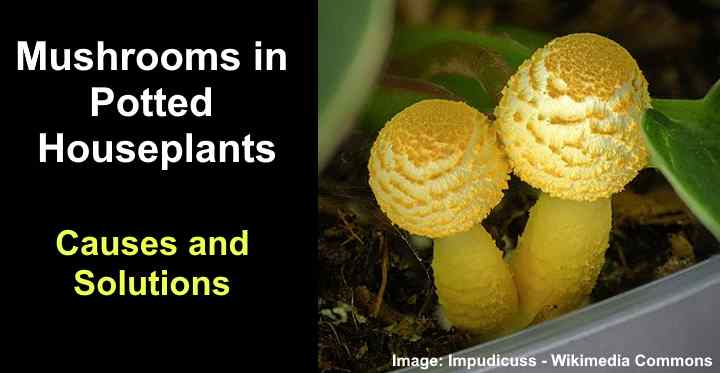
Finding small yellow mushrooms in potted plants is common. However, you may be worried about the appearance of these yellow stems with caps growing around your houseplants. The tiny yellowish mushrooms typically appear in moist soil when the temperature is warm and humid. But should you be worried if you spot mushrooms in potted plants?
The good news is that mushrooms in potted plant soil are typically nothing to worry about. However, it could signify you need to change your houseplant care techniques. All types of fungi thrive in damp, dark, humid conditions. So, unless those are the care requirements for your potted plants, you should change tactics.
For example, your prized houseplant could be at risk from root rot caused by soggy potting soil. Or a lack of sunlight could stress the plant, making it susceptible to pests and diseases. These unwelcome conditions are more likely to damage indoor plants than the appearance of small yellow mushrooms.
This article discusses the causes of yellow and white mushrooms in potted plants. It also provides solutions to eradicate these unwanted fungi from your houseplants.
Yellow Houseplant Mushrooms
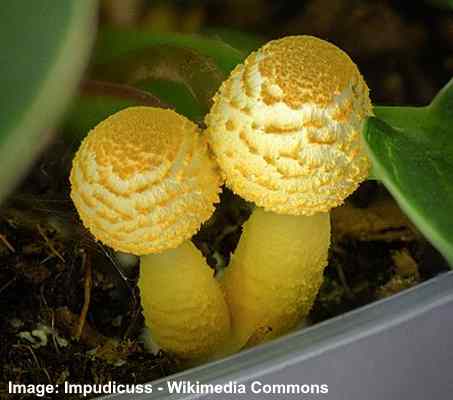
Yellow Leucocoprinus birnbaumii mushrooms growing in a houseplant pot
Yellow mushrooms growing in houseplant potting soil are typically Leucocoprinus birnbaumii — a species of gilled fungi in the family Agaricaceae. These yellow, spongy mushrooms are commonly called the yellow parasol, plantpot dapperling, flowerpot parasol, or lemon-yellow lepiota mushrooms. Some people just call them yellow houseplant mushrooms.
The yellow potted plant mushroom may start as a light or pale-yellow patch on the potting soil surface. Then small clusters of stemmed mushrooms with rounded, umbrella-shaped, or conical caps may appear. Finally, the mushroom clusters can become bright yellow and have several small fungi in a cluster.
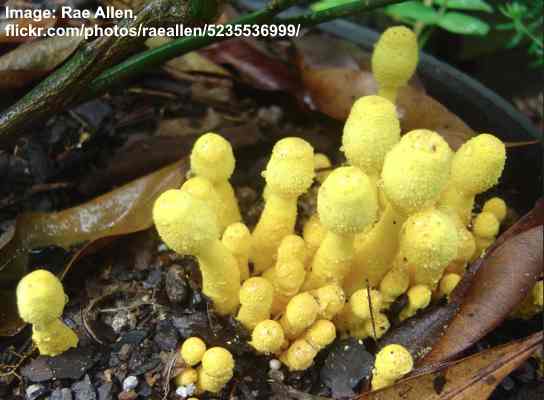
A cluster of Leucocoprinus birnbaumii mushrooms in a pot
Yellow houseplant mushrooms have a stem of 1” to 3.5” (2.5 – 9 cm) long. The bulbous cap becomes cylindrical and then sometimes flattened. The lemon-yellow cap can grow 0.78” to 3” (2 – 7.5 cm) wide. Under the cap are sulfur-yellow gills that may darken to brown with age.
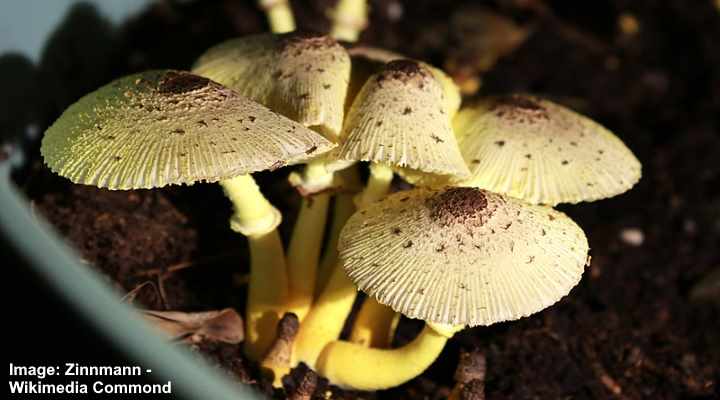
Two day old Leucocoprinus birnbaumii mushrooms in a flower pot where they develop flat caps
Leucocoprinus birnbaumii is classified as a tropical or subtropical fungus species. However, it is common in temperate regions, where it can seem to appear from nowhere in houseplant soil and greenhouses.
The microscopic spores in soil can lay dormant for several months and then start fruiting under the right conditions. For this reason, the small yellow mushrooms seem to appear suddenly, despite the plant soil never showing signs of a mushroom infestation.
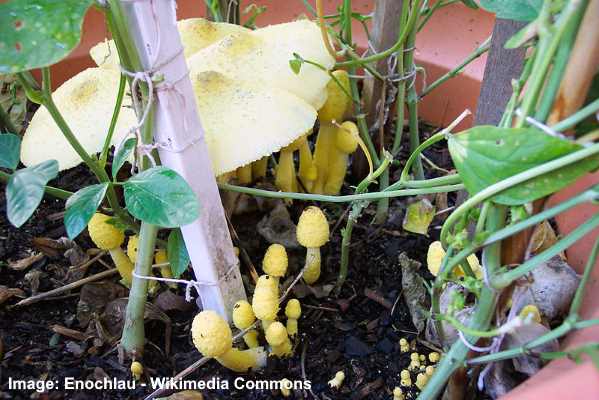
Leucocoprinus birnbaumii mushrooms growing in potting soil
For some houseplant lovers, seeing small, bright yellow mushrooms in potted plants is something beautiful. The mushrooms don’t harm plants, so they can continue growing. However, for others, the yellow mushrooms are imposters. And getting rid of the mushrooms is a priority.
White Mushrooms in Potted Plants
White mushrooms in houseplant soil are typically the same species of fungi as yellow mushrooms — Leucocoprinus birnbaumii. However, these fungi can be pale yellow, almost white, depending on the growing conditions. These mushrooms also drop white spores, which may look like white dust on plant soil.
The white mushrooms in potted plants could also be a related species Leucocoprinus flavescens. This has a white cap with a brownish center, and it grows for the same reasons as the yellow flowerpot mushroom. Like its yellow counterpart, it is harmless to plants.
When Do Mushrooms Appear in Potted Plants?
Yellow mushrooms in potted plants typically appear in summer, around July and August. Summer is the time when conditions are right in the soil for the fungus spores to fruit. During this time, the household air is usually moist, warm, and humid — perfect for small yellow mushrooms to start growing in contaminated potting soil.
How to Identify Mushrooms in Potted Plants
The identifying features of mushrooms growing indoors are the yellow color, the cap’s shape, the gills’ color, and size. Because Leucocoprinus birnbaumii is the most common yellow to pale-yellow mushroom in potting soil, the species are easy to identify. It’s rare to find another mushroom species in houseplant pots.
Where Do Mushrooms in Potted Plants Come From
Where do yellow mushrooms in houseplant soil come from? This is a common question because the yellow fungal growths can suddenly appear. The mushrooms fruit from microscopic spores or threadlike fungal roots (mycelium) in the soil. These can be dormant for several months until the right conditions occur.
Typically, the fungal spores are already in the houseplant soil mix when you buy it. Even in a soilless potting mix, these microscopic spores can be there. Once they are in the soil, getting rid of them is difficult. So, just because the yellow mushrooms appeared recently doesn’t mean the spores recently infected the soil.
Do Mushrooms in the Soil Benefit Potted Plants?
Yellow mushrooms in potting soil can benefit plants. Fungi break down organic matter in the soil, providing plants with essential nutrients and improving soil structure. Also, the mushroom roots connect with the plant’s roots, helping it to absorb more water. For some houseplant owners, small yellow mushrooms are an aesthetically-pleasing addition to indoor plants.
There are two ways clusters of yellowish mushrooms can boost plant health.
First, mushrooms lower the soil’s pH levels and increase the nitrogen and phosphate content. These are vital nutrients for healthy plant life. Secondly, mushrooms communicate through their roots (mycelium), creating an underground network.
Researchers at UCDavis report that the underground signals can alert nearby plants if a plant is threatened. This boosts the plants’ defense mechanisms to withstand parasitic fungal attacks better. Of course, this doesn’t help plants growing in separate pots. But it helps to show the benefits of mushrooms to houseplant soil.
Are Mushrooms Harmful to Potted Plants?
Mushrooms don’t harm potted plants. Unlike other types of fungal infections, mushrooms play a vital role in the soil’s ecosystem. They feed on decaying organic matter like old leaves or roots. They then return beneficial nutrients to the soil for your plants to feed on.
Because of this, yellow mushrooms don’t compete for the same nutrients in soil because they absorb different nutrients than your houseplants. Therefore, rather than harm your houseplants, yellow and white mushrooms in plant pots are a good thing.
Although mushrooms growing in plant pots don’t harm houseplants, they could signal underlying issues that threaten plants. For example, houseplant mushrooms prefer damp conditions, opposite to most houseplants. Therefore, they could be a sign you are overwatering your plants.
Indoor plants tend to suffer from excessive moisture, soggy soil, or damp conditions. So, you should limit watering plants to whenever the top 1” to 2” (2.5 – 5 cm) of soil is dry. This will avoid putting your houseplants at risk of fungal or bacterial root diseases.
Therefore, you usually don’t have to remove the mushrooms from potting soil to benefit plant health. Instead, it would be best if you think about changing your houseplant watering schedule, improving soil drainage, or putting plants in a sunnier location.
What To Do About Potting Soil with Mushrooms
Generally, you don’t need to do anything about yellow mushrooms growing alongside potted plants. The yellow fungi can give the plants an interesting visual appeal. And if your houseplants must grow in damp soil, the mushrooms are a sign that the plants are healthy.
However, you may not want to see unwanted visitors in your plants. Therefore, you can remove them by digging up the roots and disposing of the fungi. But it’s good to remember this may not get rid of them for good. This is because the gills on the underside of mushroom caps drop microscopic spores. These will grow into more fungi under the right conditions.
Are Mushrooms Growing in Potted Soil Harmful to People?

Don’t ingest Leucocoprinus birnbaumii mushrooms as they are poisonous to humans and pets
Yellow mushrooms are harmless to people if you touch them. However, Leucocoprinus birnbaumii mushrooms are considered toxic. Therefore, you should not eat the yellowish growths.
According to Iowa State University, the mushrooms are poisonous when ingested. Eating the mushrooms may not kill you, but they can cause gastrointestinal upset, vomiting, and diarrhea.
Therefore, removing the plantpot dapperling mushrooms from potted plants is advisable if you have children or pets. But it’s good to remember that touching the mushrooms won’t harm you.
Related reading: Types of edible mushrooms.
Can Mushrooms in Potting Soil Harm Pets?
Yellow mushrooms in indoor plant pots can harm cats and dogs if they ingest the fruiting bodies. The symptoms in pets from eating the small mushrooms are the same as for humans. Your pet could experience stomach pain, diarrhea, and vomiting.
Six Reasons Mushrooms Grow in Houseplant Soil
It can be challenging to figure out how fungus spores got into the plant soil. Sometimes, yellow mushrooms can start growing, even though the fungi never appeared in previous years. In many cases, there is no definitive way to tell exactly why the mushrooms started growing. The chances are that it was one of the following six ways:
1. Excess humidity can cause mushrooms to grow in potted plants
Yellow flowerpot mushrooms thrive in humid conditions when there is excessive soil moisture. They are common in potted plants in areas that have humid summers. Therefore, in July and August, you may find small, round, yellowish growths in potting soil. Also, a humidifier for houseplants could make conditions optimal for mushroom growth.
2. Using garden soil in plant pots
As a rule, never use garden soil for your houseplants. Soil from your garden contains friendly and harmful microbes and probably has millions of fungi spores. Instead of using garden soil for indoor plants, use a commercial potting mix suitable for your plant. You can also make your own DIY potting mix for various types of houseplants.
3. Overwatering
Overwatering houseplants can cause a sudden growth of flowerpot parasol mushrooms. The soil’s excessive moisture and warm air temperature cause the fruiting bodies to grow. However, you don’t need to worry about mushrooms when overwatering plants. Houseplants sitting in saturated soil risk developing root rot.
If you notice signs of root rot — poor growth, yellowing leaves, or wilted brown leaves — you should repot the plant immediately. First, check the roots for mushy, brown roots and remove them as necessary. Then, repot your plant in fresh potting soil.
To avoid moisture issues in the future, only water houseplants when the top layer of soil is dry. This watering method prevents root rot and may hinder mushrooms from growing.
4. Contaminated potting soil can have fungus spores
One reason yellow mushrooms grow in potted plants is that the soil is contaminated. Even in a soilless potting mix, microscopic spores can be lurking there, waiting for the right conditions to start fruiting.
5. Mushrooms spores got into the soil
A possible reason for the sudden growth of yellow mushrooms in potting soil is spore spread. Mushrooms release microscopic spores that carry on the wind or get transported on clothing. For example, in humid climates, the spores can blow in through open windows. Or the plant already had spores when you bought it at the gardening store.
6. Potting soil is too rich
Although mushrooms in potting soil are a sign of good health, it could be that the fertile mix caused the mushrooms to sprout. Rather than being a bad sign, it shows that there are plenty of soil nutrients to support plant health and mushroom growth.
How to Get Rid of Mushrooms in Potted Plants
How can you get rid of mushrooms growing in your potted plants? Typically, you will need to remove them by hand, change the potting soil, and change your watering techniques. Let’s look at these ways in more detail.
Handpick mushrooms to remove them from houseplant pots
The easiest way to remove yellow mushrooms is to remove them manually. You can take a small trowel and take out as much of the fungus root from below the surface. Then you can put the mushrooms in a sealable bag in the trash.
Removing the mushrooms while the yellow cap is still bulbous before it opens is best. This is because it disperses spores when the mushroom develops the umbrella-shaped or parasol cap.
Repot the houseplant with fresh soil
If yellow mushrooms come back year after year in your houseplants, you will need to change the potting soil completely. Buy a new soil mix from a reputable seller to ensure the best quality. Take care when removing the plant from the contaminated mix to prevent further spore spread.
After removing and trashing the soil, thoroughly clean the pot with soapy water to remove any traces of fungus spores. Then repot the plant with the fresh potting soil mix.
Unfortunately, this may not entirely resolve issues with mushrooms in potted plants. The spores could still be attached to parts of the plant roots.
Remove the top layer of soil to eliminate mushrooms from potted plants
If you do not want to repot the plant, you could change the top layer of soil. To do this, remove the top 2” (5 cm) of soil and replace it with a fresh potting mix. However, this solution is rarely successful in completely stopping mushroom growth if the mycelium is deep in the soil around the roots.
Change watering schedule, temperature, and humidity
Yellow mushrooms will not grow if they don’t have ideal conditions. Therefore, the spores will lay dormant in the soil until the temperature, humidity, and soil moisture levels increase. For example, suppose you water houseplants correctly and keep relative humidity levels medium. In that case, you should avoid seeing yellow growths in your plant pots.
How to Prevent Mushrooms Growing in Potted Plant Soil
The best way to prevent yellow conical-capped mushrooms from growing in potted plants is to keep the soil on the dry side.
The best watering technique for plant pots is to wait until the top layer of soil is dry to a depth of 2” to 3” (5 – 7.5 cm). Next, thoroughly drench the soil until water drips from the pot’s drainage holes. Then, wait until the excess water is drained before putting the plant pot back on its drip tray or saucer.
Related articles:
